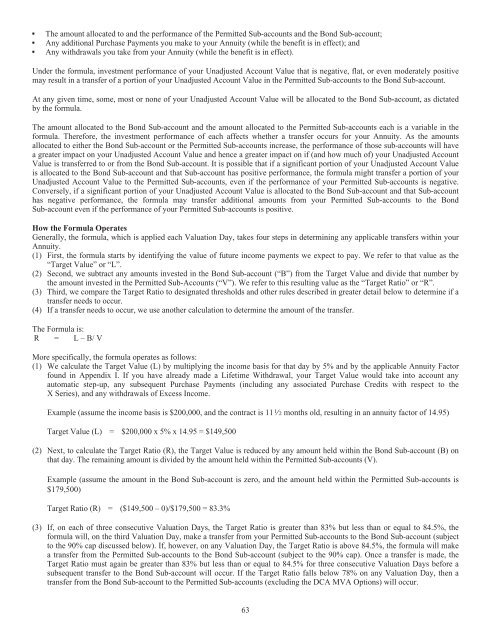Prudential Premier Retirement Variable Annuities
Prudential Premier Retirement Variable Annuities
Prudential Premier Retirement Variable Annuities
You also want an ePaper? Increase the reach of your titles
YUMPU automatically turns print PDFs into web optimized ePapers that Google loves.
▪ The amount allocated to and the performance of the Permitted Sub-accounts and the Bond Sub-account;<br />
▪ Any additional Purchase Payments you make to your Annuity (while the benefit is in effect); and<br />
▪ Any withdrawals you take from your Annuity (while the benefit is in effect).<br />
Under the formula, investment performance of your Unadjusted Account Value that is negative, flat, or even moderately positive<br />
may result in a transfer of a portion of your Unadjusted Account Value in the Permitted Sub-accounts to the Bond Sub-account.<br />
At any given time, some, most or none of your Unadjusted Account Value will be allocated to the Bond Sub-account, as dictated<br />
by the formula.<br />
The amount allocated to the Bond Sub-account and the amount allocated to the Permitted Sub-accounts each is a variable in the<br />
formula. Therefore, the investment performance of each affects whether a transfer occurs for your Annuity. As the amounts<br />
allocated to either the Bond Sub-account or the Permitted Sub-accounts increase, the performance of those sub-accounts will have<br />
a greater impact on your Unadjusted Account Value and hence a greater impact on if (and how much of) your Unadjusted Account<br />
Value is transferred to or from the Bond Sub-account. It is possible that if a significant portion of your Unadjusted Account Value<br />
is allocated to the Bond Sub-account and that Sub-account has positive performance, the formula might transfer a portion of your<br />
Unadjusted Account Value to the Permitted Sub-accounts, even if the performance of your Permitted Sub-accounts is negative.<br />
Conversely, if a significant portion of your Unadjusted Account Value is allocated to the Bond Sub-account and that Sub-account<br />
has negative performance, the formula may transfer additional amounts from your Permitted Sub-accounts to the Bond<br />
Sub-account even if the performance of your Permitted Sub-accounts is positive.<br />
How the Formula Operates<br />
Generally, the formula, which is applied each Valuation Day, takes four steps in determining any applicable transfers within your<br />
Annuity.<br />
(1) First, the formula starts by identifying the value of future income payments we expect to pay. We refer to that value as the<br />
“Target Value” or “L”.<br />
(2) Second, we subtract any amounts invested in the Bond Sub-account (“B”) from the Target Value and divide that number by<br />
the amount invested in the Permitted Sub-Accounts (“V”). We refer to this resulting value as the “Target Ratio” or “R”.<br />
(3) Third, we compare the Target Ratio to designated thresholds and other rules described in greater detail below to determine if a<br />
transfer needs to occur.<br />
(4) If a transfer needs to occur, we use another calculation to determine the amount of the transfer.<br />
The Formula is:<br />
R = L – B/ V<br />
More specifically, the formula operates as follows:<br />
(1) We calculate the Target Value (L) by multiplying the income basis for that day by 5% and by the applicable Annuity Factor<br />
found in Appendix I. If you have already made a Lifetime Withdrawal, your Target Value would take into account any<br />
automatic step-up, any subsequent Purchase Payments (including any associated Purchase Credits with respect to the<br />
X Series), and any withdrawals of Excess Income.<br />
Example (assume the income basis is $200,000, and the contract is 11 1⁄2 months old, resulting in an annuity factor of 14.95)<br />
Target Value (L) = $200,000 x 5% x 14.95 = $149,500<br />
(2) Next, to calculate the Target Ratio (R), the Target Value is reduced by any amount held within the Bond Sub-account (B) on<br />
that day. The remaining amount is divided by the amount held within the Permitted Sub-accounts (V).<br />
Example (assume the amount in the Bond Sub-account is zero, and the amount held within the Permitted Sub-accounts is<br />
$179,500)<br />
Target Ratio (R) = ($149,500 – 0)/$179,500 = 83.3%<br />
(3) If, on each of three consecutive Valuation Days, the Target Ratio is greater than 83% but less than or equal to 84.5%, the<br />
formula will, on the third Valuation Day, make a transfer from your Permitted Sub-accounts to the Bond Sub-account (subject<br />
to the 90% cap discussed below). If, however, on any Valuation Day, the Target Ratio is above 84.5%, the formula will make<br />
a transfer from the Permitted Sub-accounts to the Bond Sub-account (subject to the 90% cap). Once a transfer is made, the<br />
Target Ratio must again be greater than 83% but less than or equal to 84.5% for three consecutive Valuation Days before a<br />
subsequent transfer to the Bond Sub-account will occur. If the Target Ratio falls below 78% on any Valuation Day, then a<br />
transfer from the Bond Sub-account to the Permitted Sub-accounts (excluding the DCA MVA Options) will occur.<br />
63

















